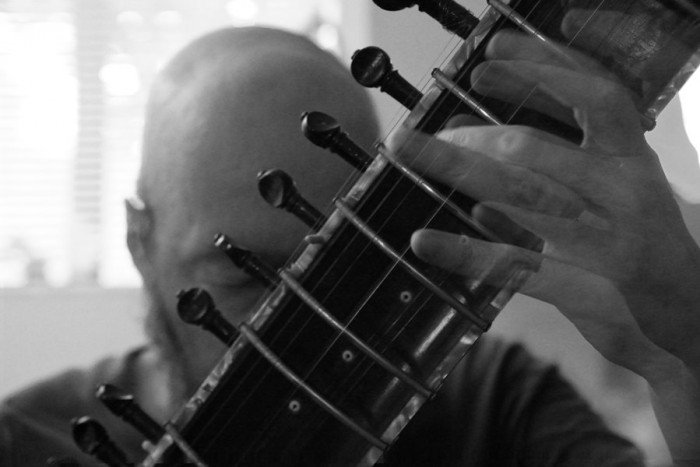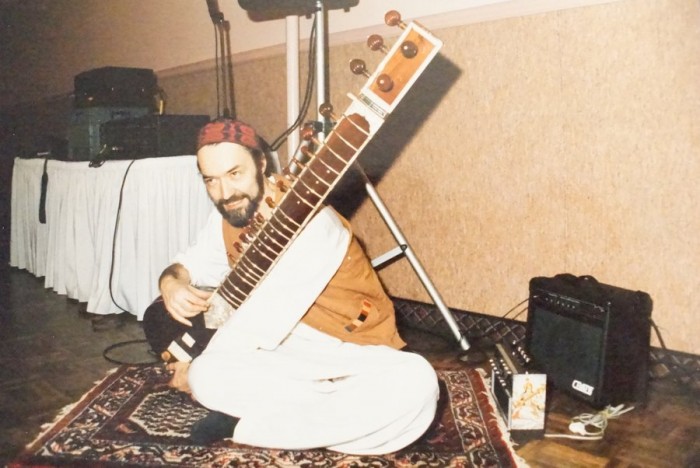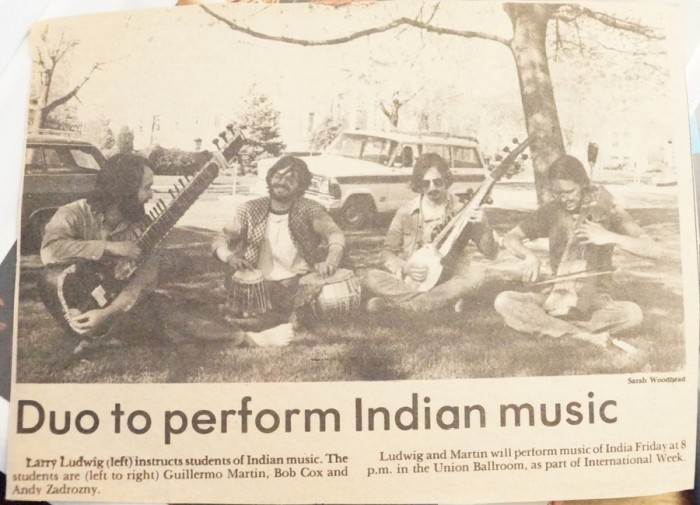
A dimly lit drawing room, the size of a small hostel dorm; the fragrance of incense sticks overpowering the nostrils; abstract paintings on the walls, carrying deep artistic sense, if only one could penetrate them; books, CDs, cassettes, stacked on shelves, some of them scattered on tables; pictures of Hindu gods alongside those of Christ; and in a corner, an Indian string instrument – the Sitar.
What’s special about this scene? By itself, nothing, except that the place must belong to a really artistic person, and artistic people are interesting by themselves. No, not just the scene, but the setting was special. Because the scene, typically Indian, was actually in an American setting. Yes, I had just walked into an American household, that of Sitarist Larry Ludwig!
I am a Sitar player myself, a Sitar student is perhaps more appropriate; and it always interests me to know the relevance of my instrument in a foreign land. And so, when I came to Seattle, the city known for its music, the one question that came to my mind was that, ‘Do people here even know what Sitar is?’
To my utmost and pleasant surprise I figured out that not only do the folks here know about the Sitar but they also play it! The next thing that came to my mind was: they must be Indians! But to my astonishment that was not true either. The classic rock band named ‘The Beatles’ is from where it all began. One of the instruments that the band used was the Sitar and those who would listen to the band and were interested in music became fans of the new instrument which was different from the usual and mainstream western musical instruments.
That is also where Mr. Larry Ludwig and Mr. Brandon McIntosh, the well known personalities in the world of classical music in Seattle, acquired their taste of music from.

Derived from the ancient Indian instrument, the ‘Veena’, the ‘Sitar’ is a string instrument. It was invented by the famous 16th century musician-poet Amir Khusro and was named “Sehtaar”, a Persian name, where ‘Seh’ stood for ‘three’ and ‘taar’ meant ‘wire’. It was called so, since at that time it had only three wires. After modifying it for about a century or two, the instrument took its present shape with seven wires in the 18th century. The Sitar is mainly used for Hindustani or the northern style of music.
In my opinion, gone are the days of the Indian Classical instruments in the Indian subcontinent (http://www.criticaltwenties.in/philosophyreligionculture/save-indian-classical-music) ; it is western music culture that is setting in steadily there! And here in the west the story seems to be quite different. Indian classical instruments which seem to be losing their charm in India are gaining popularity in the west.

Mr. Jeff Lewis and Mr. Larry Ludwig are the oldest Sitar players in the city of Seattle. ‘Its been 25 years’, remarks Mr. Ludwig, since I have been playing the sitar in Seattle’. While flipping and reminiscing through his old albums he said that he played at Kabul Restaurant on 45th street, Seattle for 14 years after which he started playing at weddings and also gave private lessons.
One of the main factors that contribute to the growth of the instrument is the increment of the Indian population in east Seattle. Thanks to Microsoft and Amazon, it is here that 50 students learn Indian classic instruments with Mr. Brandon McIntosh. ‘The interesting part being that the popularity of the instruments and the music is growing, more people are getting interested and more age groups are getting interested’, says Mr. McIntosh. His method of teaching is also something which is very innovative and unique. One of them is that, on a guitar alongside its strings he has placed the strings of the sitar which he calls ‘Sigar’, a hybrid between sitar and guitar. The students who are more comfortable with guitar but want to learn Indian music can now learn it very easily on ‘Sigar’ and as their interest grows or as and when they find it comfortable they can shift to Sitar.
This is where he makes a statement that, ‘it makes me really happy to see that music has become a point of conversation among children, they not only talk to each other about the status of their school homework while playing but also about their progress at music lessons. It sure is growing!’, he smiles.
When asked as to what they like about the instrument or about the music it creates that led them to play it and remain passionate about it for so long – Mr. Ludwig answered by saying, “There is a meditation to it which I don’t hear in the other instruments.” Mr. McIntosh stated, “I like the complexity and the depth of it. You can listen to it a hundred times and still learn something new from it always. The sound of it speaks to me like no other music.”

At the end of the day when I meet music enthusiasts such as these, I begin to believe that Indian music and Sitar have a bright future having become popular in other parts of the world. I wish both Sitar and Seattle all the very best and am sure that with the patronage of the likes of Larry Ludwig and Brandon McIntosh, Seattle will indeed hear more of the Sitar and will contribute to its further development.
This story was produced in the 2015 SUSI program.

